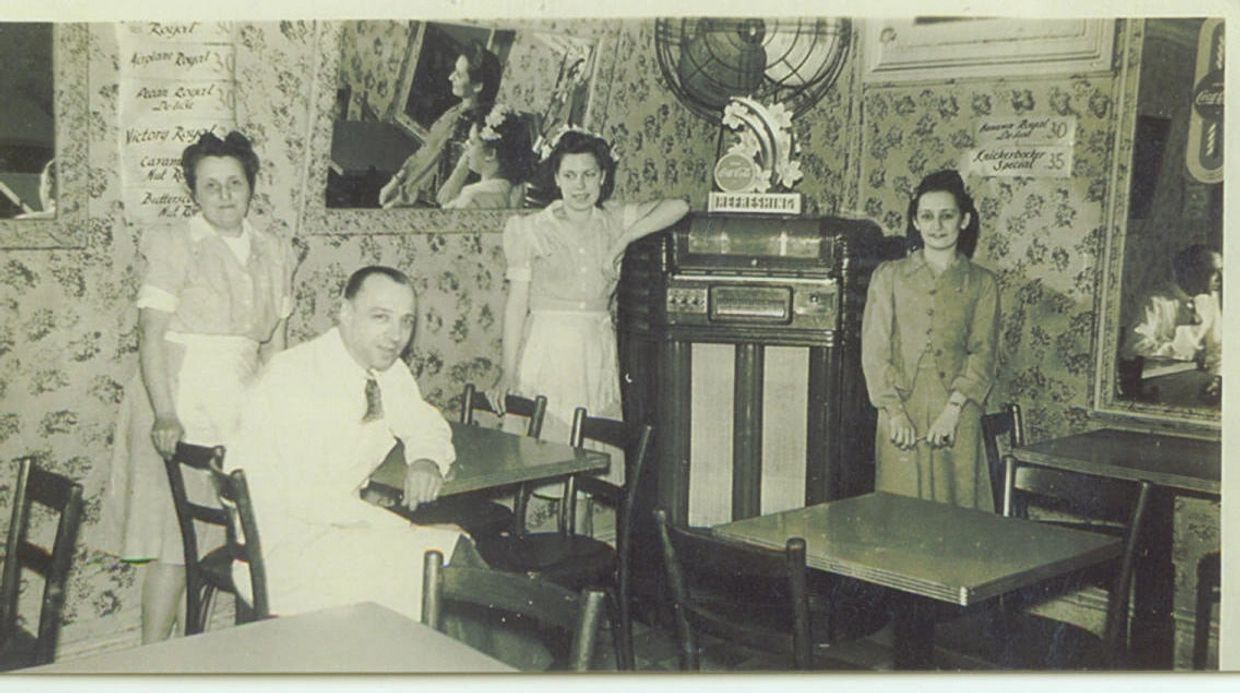
Knickerbocker's Ice Cream and Candy Co. Paterson, NJ
Knickerbocker's Ice Cream and Candy Co was a family-operated candy business in Paterson, NJ. They crafted a variety of confections, ranging from chocolates to clear toy candy.
Herman Hegeler acquired the business in 1938, originally a grocery store named "Knickerbocker's," located at 38 Main St., Paterson, NJ. Upon taking ownership, Hegeler retained the "Knickerbocker's" name but expanded it to include "Ice Cream and Candy Co." The three-story building also served as rental apartments on the upper levels. The shop featured a soda fountain on one side, glass candy displays on the other, tables, and a jukebox in the back. Additionally, Hegeler was known for delivering Dixie cup ice cream to the nearby elementary school.
Herman Hegeler's family hailed from Bremen, Germany, where his father worked as a confectioner. His wife, Gertrude Engelhaupt Hegeler, originated from Frankfurt, Germany. During their marriag,e they had one child. Both Herman and Gertrude actively contributed to the store. Known to customers as Mr. and Mrs. Knickerbocker, they became beloved figures in the community. During World War II, they received numerous letters from servicemen expressing their anticipation to return home for an egg cream or candy from Knickerbocker's. Local policemen patrolling Main St. would often visit for hot coffee or cocoa in winter and refreshing sodas during the summer. Mr. Hegeler was an enthusiast of technology, and his store pioneered several conveniences, including being the first in the area to have air-conditioning, a pay phone, and a television.
It was truly a family affair, with their daughter, son-in-law, and even grandchildren pitching in. Their involvement ranged from wiping tables to cleaning the candy counter, weighing candy and packaging it in paper bags. Local kids frequented the shop to buy "penny candy," often pointing to their selections on the cases. The store offered a diverse array of sweets sold by the pound, such as chocolate chunks, nougat of different varieties, and old-fashioned candies, some featuring nuts or raisins. Their selection also encompassed hard candies, drops, peppermints, with horehound drops being particularly popular. In the winter, candy canes were a seasonal treat. Leading up to Easter, customers from multiple states pre-ordered custom chocolate Easter bunnies adorned by Mr. Hegeler himself. He skillfully decorated bunnies, large chocolate eggs, wagons, or chicks, often inscribing names in elegant script with white icing. Additionally, the shop specialized in crafting clear toy candy, boasting an impressive collection of molds that produced everything from trains to busts of "Teddy" Roosevelt."
Equipped with several sizable pots for candy production, the workshop featured shelves and walls adorned with numerous molds. Hoping for low humidity, deemed ideal for 'candy making weather,' was a common practice, especially since the candy shop section lacked air-conditioning. A substantial marble table took center stage, serving as the platform for creating hard candy canes, ribbon candy, and other confections. Herman, donned in a white coat reminiscent of a doctor, engaged in a fascinating technique. He would place a molten candy chunk on a large hook mounted on the wall, pulling and stretching it like taffy until it achieved a shiny texture. Subsequently, he infused flavors like peppermint, introduced red coloring to one half, and occasionally added green to the other. The final touch involved twisting the candy into custom shapes or crafting candy canes, skillfully cutting it with a hatchet before it cooled too much to manipulate
Knickerbocker's closed its doors in 1971 due to the state of New Jersey executing an eminent domain suit, acquiring the building along with all the structures on 'lower Main St.' The intention was to clear the area for the construction of Route 80. However, the interstate ended up taking a different route, leaving the block as another neglected and cluttered eyesore in the declining downtown area of Paterson, NJ.
Till the day the state forced the business to close, the blackout curtains from WWII were still there. These curtains were routinely drawn after closing to provide privacy for cleanup. The storefront featured two window display areas on either side of the front door, and a nightly rolled-up canopy adorned the front entrance. Operating seven days a week, the shop maintained extensive hours, from 9 AM until Midnight until the year 1968.
Photo Above
Gertrude Engelhaupt Hegeler, standing on left and Herman Hegeler sitting.
The two on the right were waitresses. Photo curtsy Rene McCullers.
Knickerbocker's Images






